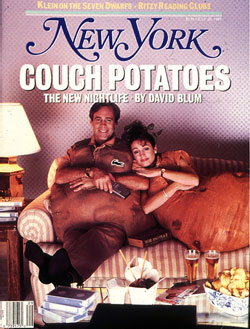 |
From the July 20, 1987 issue of New York Magazine.
We are dealing with a confirmed Couch Potato in Gil Schwartz, who describes a recent Thursday night as one of the most horrible, agonizing, and generally wretched evenings he has spent during his 36 years on the planet.
Schwartz has been married for almost a decade. He is a middle manager for a large corporation and has two children—Nina, four, and Willie, one. On the night in question, he stayed home long enough to kiss them good night.
Then the horror began:
"Around eight o'clock, I meet a couple of friends for dinner at Teacher's Too, on Broadway, where we all order the Chicken Gai Yaang," Schwartz reports. "At this point, I'm already tired. Then begins the inexorable pull southward. I'm dragged kicking and screaming by my friends to the Lion's Head, in Greenwich Village, where I stare wistfully at people younger than myself. Then we move on to some downtown nightclub where everyone was looking for Jay McInerney, hoping to have our conversation overheard by the next Hot Young Novelist.
"By now," Schwartz says, "I would much rather be at home drinking scotch from my own bottle of Dewar's and watching The Heartbreak Kid on cassette."
It's 11:30 P.M. Normally, at this hour Schwartz would be watching Honeymooners reruns, or snoring.
"But instead," he says, his voice darkening at the memory, "I am in a neighborhood far, far away . . . where there are no cabs."
Schwartz would prefer to be at rest, seated or supine, on something soft. He would prefer to have rented The Terminator for the fifth time from the Video Vault, ordered beef with broccoli from Hunan Balcony, and kept cozy in his Upper West Side apartment. Occasionally, he reads a book or a magazine. ("Once you leave your house," he observes, "it is very difficult to read a magazine.") He spent a lot of money renovating his apartment on an upper floor, and he would just as soon stay inside it.
For Schwartz, there is no choice between a night on the town and a night lying down. He is bored with nightclubs, tired of movie lines, sick of scenes. He is the prototype of a new urban species that has evolved in the years since the baby-boom generation decided to get married and have children.
He is one of the new Couch Potatoes.
Immediately, this raises some provocative questions. What about all those people in restaurants? And all those tickets sold for Broadway shows? Who's going to the ballet? The Palladium? The Loews 84th Street? And what about all those people who are still looking for the perfect spouse? Aren't they still going out every night? Is this some kind of blip on the sociological curve, one that doesn't really exist? How can anyone document what people aren't doing?
The Couch Potato phenomenon is the result of three increasingly important facts of baby-boom life: marriage, children, and home video (not necessarily in that order). Of course, every generation has its own natural ebb and flow of social activity. But in the last twenty years, drugs like cocaine provided the stamina for late-night life, and hallucinogens like LSD and marijuana made the world beyond apartments seem that much more exciting and different. Rock music and pop culture took off in a late-night direction, with discos and night-clubs open till morning for those who could never get enough. And those who were a part of the sixties "youthquake" have been especially resistant to the notion of growing up. Now they're doing it with a vengeance.
"We see it everywhere. People don't want to go out anymore; they'd rather stay in their living rooms," says Keith McNally, the 35-year-old co-owner of Nell's. "And fortunately, we made our club look as much like a living room as we possibly could. Frankly, I'm not the type that likes to go to discos and nightclubs; I'd rather stay home and listen to an album. And that seems to go for almost everybody."
A recent Gallup Poll bears out the stay-at-home theory. In an April 1986 survey that asked the question "What is your favorite way of spending an evening?" one third of all Americans chose the TV set as the preferred means of entertainment. The number of people who gave "resting, relaxing" as their favorite activity—which a Gallup spokeswoman said includes sleeping or stretching out on the sofa—had nearly doubled since 1974, to 14 percent.
As one might expect, sociologists take the stay-at-home trend seriously.
"The need to stay at home begins with a change in life-style, and of course marriage and children contribute to that in this generation," says Eviatar Zerubavel, a sociologist at the State University of New York at Stony Brook who has studied how people use their time. But he believes that part of the trend is a basic change in attitude toward the home itself.